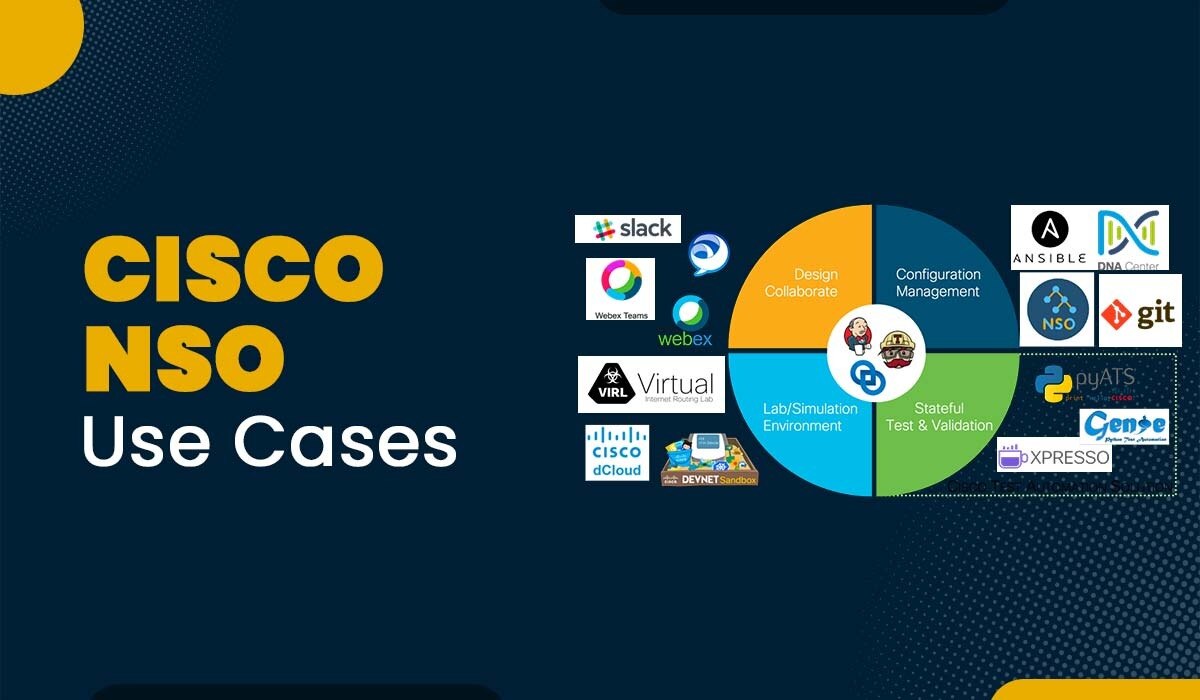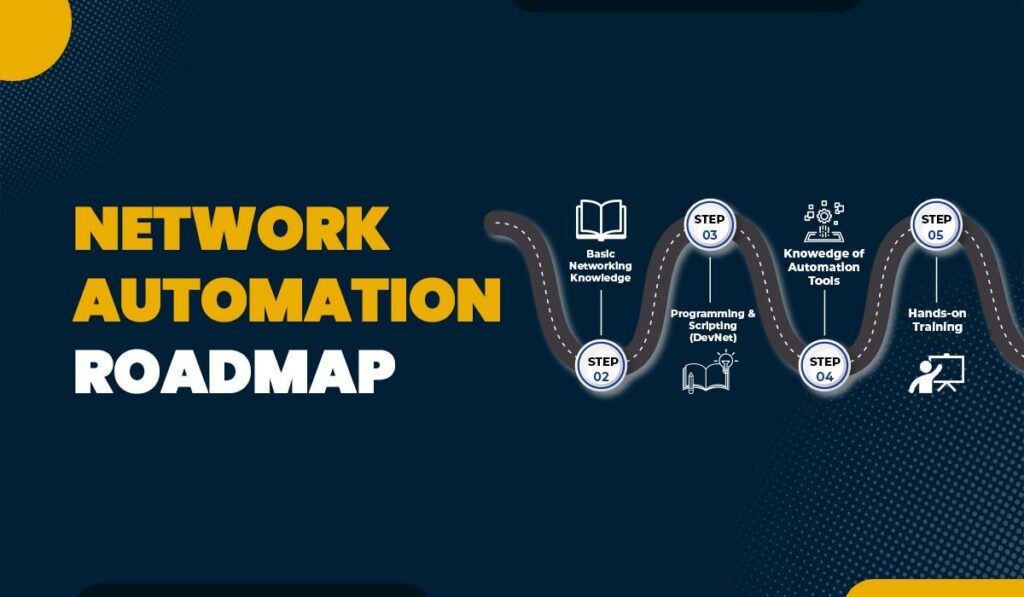Introduction
In today’s complex networking environment, managing devices as well as offering the best services remains central for any company irrespective of size. Cisco NSO is a robust solution that has been designed in order to simplify the process of network automation as well as management. When implemented, Cisco NSO encourages organizations to save time, reduce errors, and in the process, boosts effectiveness and efficiency while improving the performance of the network. In this blog, we will discuss the end-to-end Cisco NSO use cases in detail.
We will provide insights into how Cisco NSO can be applied in different scenarios, including device turn-up, NFV orchestration, SD-WAN management, and more. At the end of this blog, you will understand the use cases of Cisco NSO and for efficient use of this solution, you can take our Cisco NSO Training.
Let us first discuss the basics of Cisco NSO before getting into the Cisco NSO use cases.
What is Cisco NSO?
Cisco Network Services Orchestrator, or NSO, for short, is a solution that offers a single point of control for networks. Therefore, it assists network operators in building services on the different devices and governs them with ease. With Cisco NSO, the integration of new services is faster and easier; there is less need for manual configuration and, therefore, fewer chances of making a mistake.
Cisco NSO also offers the ability to work with many network devices as well as the technologies that are included in it with the help of model-driven programmability. It supports any connected network devices in the network such as routers, switches, firewalls, and virtualized network functions (VNFs). Cisco NSO uses templates through which the underlying complexities are hidden and hence, users can focus on the service lifecycle, from design to deployment.
Also, it is worth mentioning that Cisco NSO can interact with various orchestration and management systems to support smoother interaction across complex networks. Due to these features, it has become a very crucial tool used by modern network operators who wish to increase the flexibility of their networks.
Let us move on to another section where we will discuss different use cases of Cisco NSO.
Common Cisco NSO Use Cases
Cisco NSO can be used in different scenarios across organizational networks. Here, we will shed some light on a few specific Cisco NSO use cases to show how versatile and beneficial they can be.
NSO for Device Turn-up
One of the Cisco NSO use cases is Device turn-up. It involves the process of adding or configuring new network devices and integrating these network devices within an existing network. This is done in various stages, such as IP addressing, network setup, and provisioning of essential services.
When it comes to performing device turn-up with Cisco NSO, it is possible to automate most of the work. By defining the device configurations with the help of the model-driven APIs, the network engineers can easily deploy new ones with much less need to interfere manually. The NSO platform enables operators to apply system configurations on different devices, allowing for standardization as well as adhering to the best industry practices.
In addition, the fact that the Cisco NSO is able to communicate with various inventory systems enables tracking of new devices being introduced into the network. This helps you to keep track of all new devices so that you are protected from mistakes and your management responsibilities become lighter. In the long run, Automated device turn-up through Cisco NSO improves operational efficiency and leads to a faster and more accurate extension of the network.
NSO for NFV Orchestration
Network Functions Virtualization, also known as NFV, is a technology that allows the virtualization of network functions such as firewalls, routers, load balancers, and others. This will allow them to run on commodity hardware rather than proprietary devices. NFV Orchestration involves the creation, installation, and configuration, as well as scaling and removal of these virtual services.
Cisco NSO is a critical element of NFV orchestration since it provides a centralized point for management. Mainly, it enables the operators to efficiently automate the deployment and scaling of VNFs. Another benefit of utilizing Cisco NSO in this context is its capability to integrate between different virtual and physical networking components.
In the case of operators, Cisco NSO provides an option to set service logic to provision VNFs totally based on real-time demand. For example, if the network traffic increases, NSO can quickly deploy several more virtual firewalls to meet the demand. It means there will be better resource management and lower operational costs.
NSO for SD-WAN Orchestration
Among many use cases of Cisco NSO, SD-WAN orchestration stands apart. Software-defined Wide Area Networking (SD-WAN) can be defined as the usage of software-defined networking technology in order to manage as well as optimize WAN connections. It enables an organization to route traffic flow in a smart manner across different connection types like MPLS, LTE, broadband, etc.
Cisco NSO strengthens the SD-WAN orchestration capability by automating and optimizing the management of services on the network in different settings. As mentioned, NSO allows network operators to easily deploy and manage SD-WAN services at branch locations, thereby enforcing the same policy across the network and reducing configuration issues.
Furthermore, Cisco NSO facilitates centralized policy management of SD-WAN, which implies the ability of the operators to adjust traffic totally based on real-time application performance metrics. It is particularly valuable for tuning the network within an application and guaranteeing an ideal user experience. In having more centralized and coordinated control of SD-WAN through Cisco NSO, organizations can greatly simplify and streamline their processes.
NSO for ACL Management
Another use cases of Cisco NSO are the management of ACL. ACLs or Access Control Lists are important for networks, especially for security, since they work well in determining what traffic is allowed or denied from getting in or out of network devices. In general, proper ACL management also helps to guarantee the secure operations of networks.
Cisco NSO offers solutions to manage ACLs simply, enabling network operators to create, modify as well as clear the ACL entries on the devices easily within the network. In NSO, network engineers can easily apply ACL changes. This ensures that any updates are done consistently across all devices.
This centralized approach to ACL management reduces the risk of misconfigurations that could expose the network to security vulnerabilities. Furthermore, by automating the process, Cisco NSO frees network engineers from the manual workload associated with ACL updates, enabling them to focus on more strategic tasks.
NSO for QoS Management
One of the most important Cisco NSO use cases is management of QoS. Quality of Service (QoS) is crucial in providing the best network performance, especially in environments having varying application demands. QoS management aims at prioritizing only the important network traffic in order to ensure that critical applications have the capacity they require for proper functioning.
Cisco NSO can help in QoS management, where network operators can implement and configure QoS policies in the networks. With model-driven APIs, NSO allows engineers to configure QoS policies such as traffic shaping, prioritization, and allocation of bandwidth across several devices in a consistent manner.
With Cisco NSO, organizations can quickly adapt to changing network conditions and application performance needs. For example, if there is a new video conferencing application available, then through the help of NSO, it will be able to set up the appropriate QoS policies for that application. This agility results in better performance of business applications and improved satisfaction of end users.
NSO as a Power Tool for Network Engineers
Among many other Cisco NSO use cases, one is it can be used as a powerful tool for network engineers.
Cisco NSO should be regarded as an effective tool to support network engineers and improve their performance in network management. The automation and orchestration feature that NSO offers allows network teams to handle complex networking tasks easily.
NSO’s model-driven architecture provides network engineers the opportunity to work with the networks’ services part rather than the complexities of device configuration. It is possible to define what kind of service a company wants to produce at a high-level service, and then configure a device accordingly. This eradicates the possibility of making mistakes, reduces complacency, and speeds up service delivery.
NSO also has a higher-level CLI that allows network engineers to manage network devices in the network. Contrary to working with the device CLI, network engineers operate with the service models provided by NSO, and these models work with CLI commands specific to the device. This approach eliminates the need to type in the CLI since the same CLI commands can be used to manage multiple devices from the same vendor.
It is possible that network engineers can choose their favorite CLI syntax, like Cisco or Juniper, and the NSO Network Element Drivers (NEDs) make sure that the correct syntax is used for the network devices. This allows for a single and standardized front when managing a multi-vendor network so that the configuration and maintenance work for network engineers is made easier.
NSO for Config Audit
Configuration audits are the key processes one needs to consider when it comes to maintaining compliance, security, and operational integrity in network management. The use of audit checks is effective for ensuring that network devices adhere to predefined standards and policies in organizations.
Through Cisco NSO, audit of the configuration becomes less rigorous since the configurations of devices in the network are made visible. This is helpful for network operators to take current snapshots and compare them with baseline configuration or policy definitions.
Automated audits can then be performed on an organization to detect any irregularities and address them before they pose a problem to the network. This assists in maintaining current compliance with various industry standards as well as general network security. The fewer the configuration audits done with Cisco NSO, the less the operational risks meaning that a secure networking environment is provided.
NSO for OS Upgrade
Upgrading the OS on network devices is a critical task to guarantee that devices are secure and up to date with the newest features in addition to being fully functional. However, the task of performing OS upgrades often turns into a complex problem, particularly when a large number of devices are located independently in different locations.
Cisco NSO, in this regard, is advantageous because of its ability to automate the process of initiating an upgrading of the OS. OS upgrades across several devices can also be managed effectively through a single platform and at a time convenient for the network engineers.
Another benefit is the elimination of potential mistakes that may arise during the updating process, including improper configurations or overlooked devices in the case of automating OS upgrades. Through the use of Cisco NSO, the network teams are assured that all the devices in the network are upgraded to the required standards as well as meeting the required policies. This results in enhanced network reliability and security.
These are some of the common use cases of Cisco NSO.
Frequently Asked Questions
Q1. What is Cisco NSO used for?
Cisco NSO is used to simplify the management and control of network devices across multi-vendor environments by providing a higher-level, unified CLI interface for network engineers.
Q2. What are the important use cases of Cisco Secure Application?
Cisco Secure Application provides secure access, application visibility, and threat protection for cloud-based applications, enabling organizations to enable cloud adoption and digital transformation securely.
Q3. What is NSO in telecommunication?
NSO in telecommunications is a platform that automates the provisioning, management, and control of network services across multi-vendor environments, simplifying operations and enhancing agility.
Q4. What are the use cases supported by Cisco ISE?
Cisco ISE supports use cases like network access control, guest access, compliance enforcement, and endpoint security, enabling secure and efficient user access to network resources.
Conclusion
Cisco NSO is one of the revolutionary concepts in network management and automation. By understanding different Cisco NSO use cases like device turn-up, NFV orchestration, SD-WAN management, and ACL configurations, organizations can optimize their performance and adapt quickly to new requirements.
Cisco NSO is not merely an automation tool; it serves as the foundation for elevating reliability, consistency, and network performance. As businesses continue to evolve in an increasingly complex technological landscape, solutions like Cisco NSO will be essential in ensuring that networks remain agile, secure, and efficient. Integrating Cisco NSO into network management practices offers not only operational efficiencies but also the foundations for future advancements.





